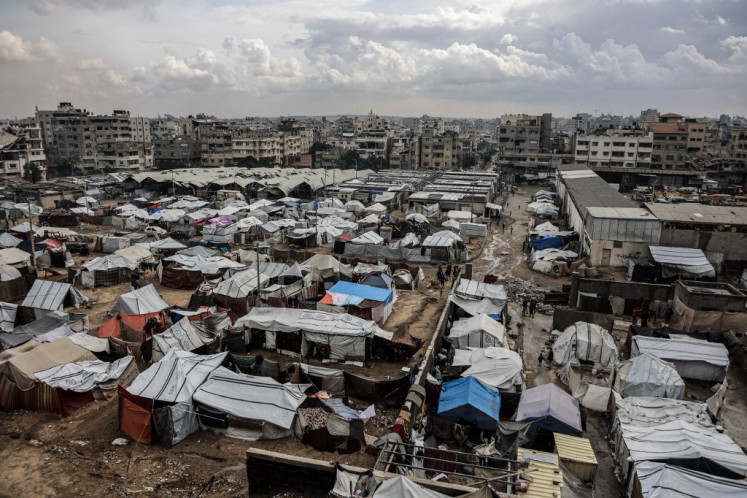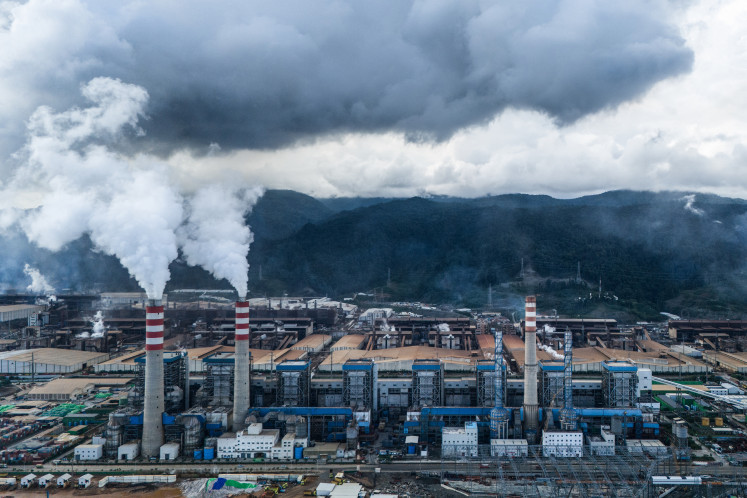Popular Reads
Top Results
Can't find what you're looking for?
View all search resultsPopular Reads
Top Results
Can't find what you're looking for?
View all search resultsTrauma therapy still needed for survivors of Sunda Strait tsunami
Healing session: Residents of Sebesi Island make handicrafts as part of trauma-healing therapy in South Lampung
Change text size
Gift Premium Articles
to Anyone
H
ealing session: Residents of Sebesi Island make handicrafts as part of trauma-healing therapy in South Lampung. The therapy is expected to help the residents, especially women, recover from trauma resulting from a tsunami in December 2018.(JP/Andi Muhammad Ibnu Aqil)
Bandriah, 28, stuffs a toy cat with Java cotton, while recalling the day when a tsunami struck her home island of Sebesi on the Sunda Strait, South Lampung. While concentrating intently on what she is doing, she recounts the traumatic experience of the tsunami hitting her neighborhood late last year.
“I loved my parents the most. My father died when I was 5 years old so I lived with my grandmother here in Tejang,” Bandriah said while continuing with her craftwork.
Sobbing, Bandriah explained that she lived with her grandmother on the island until she finished junior high school and then she moved in with her mother and stepfather.
The woman was doing craftwork as a means to heal the trauma caused by the tsunami
“She no longer has her grandmother, that’s why she is sad,” Salma Indria Rahman said while consoling Bandriah in a one-on-one trauma counseling session specifically for the women of Sebesi Island.
When the area was struck by the tsunami, which was caused by the eruption of Mount Anak Krakatau on Dec. 22, 2018, Bandriah was at home watching TV when she heard neighbors shouting a warning for everyone to flee their houses because large waves were heading their way. The house that she and her husband lived in with their 8-year-old-son was just a few meters from the coast.
“We were shaking and ran here to emak’s [mother] house. After that we went [to the evacuation site],” she said, referring to a designated evacuation site on a hill on the island. They remained there for three days with other villagers, some of whom occasionally returned home to cook fish and rice to take back for everyone to eat.
She said that at the time she and other villagers were so panicked that they took few belongings with them, although some did take blankets with them.
Her house was not demolished by the tidal waves, but she was reluctant to go back because she discovered in February that she was one month pregnant.
Salma said Bandriah was initially reluctant to attend trauma therapy sessions and would remain quiet. She started to open up after a few sessions, which Salma and the People's Coalition for Fisheries Justice (KIARA) run for women on Sebesi Island who were traumatized by the natural disaster.
Rohilahwati, 46, was also traumatized by the tsunami, even though she, her husband, daughter and son were all safe after fleeing their house, where the water entered only the kitchen.
Like many other evacuees, Rohilahwati and her family members fled to the evacuation site on the hill. She later heard that food aid would be provided.
“My husband went down [the hill to get food aid], but the aid had run out,” she said.
To survive, Rohilahwati and her family ate boiled bananas that they had picked.
“We cried because we did not get food aid when it came. Luckily there were banana trees around,” she said.
She said the experience made her fear for her life at times, and she was depressed. For that, she turned to her husband and neighbors for comfort.
“I would sometimes talk with neighbors while foraging for vegetables,” Rohilahwati said.
And when Salma and KIARA came to Sebesi and offered the trauma therapy sessions that involved sewing lessons, Rohilahwati decided to join in.
“As long as it’s useful then I am happy to participate,” Rohilahwati added.
At the trauma therapy sessions, Salma taught the women how to sew and make things such as hats, stuffed toys and purses, while telling them to coexist with nature and to talk about their fears caused by the tsunami with those to whom they were close.
Salma said that helping victims of natural disasters should not end at helping them with financial needs. Trauma therapy was also needed, especially for the most vulnerable such as children and women.
KIARA secretary-general Susan Herawati said the trauma therapy sessions also helped in the gauging of how much the people knew about disaster mitigation to help them deal with past traumas and help them prepare should another disaster strike.
She said she hoped that the trauma therapy sessions would help build solidarity among the residents.










